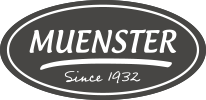As a devoted dog owner, you're no stranger to the responsibility that comes with ensuring your beloved furball is maintaining a healthy diet. It's no walk in the park to sift through the vast array of options out there. And not just the packaging, there's the mystery that is the biggest puzzle of all - the labels on your dog's food and treats.
Dog food labels can be full of terms and ingredients that often seem like they come straight out of a science textbook. Ever found yourself squinting at a seemingly cryptic code of percentages, nutritional breakdowns, and an endless list of ingredients? You're not alone.
In this article, we aim to shed light on the important elements of dog food labels, decode those confusing terms, and provide insights about how Muenster produces food and treats to help you make informed decisions about what you feed your cherished companion.
Are there regulations or standards for dog food labeling?
Yes, The American Association of Feed Control Officials (AAFCO) is the shepherd for all things related to animal feed, and that includes our lovable little pooches' chow too. It's important to note that, AAFCO does not regulate, test, approve or certify pet foods in any way, but it does own and build the rulebook. If a food doesn't meet the standards set by AAFCO, it won't be approved for sale by the Food and Drug Administration (FDA), which often utilizes the Office of the State Chemist within each state.
What does the guaranteed analysis on a dog food label tell me?
Grasping the term 'Guaranteed Analysis' is akin to gaining an X-ray vision that reveals a food product's nutritional value, but for dog food packages instead. When you spot ‘guaranteed analysis,' understand that it's the pet food manufacturer's way of informing you about the primary nutrient categories present in that product.

Scouring the label, you'll typically see these four crucial nutrients earmarked: protein, fat, fiber, and moisture. But what does this really mean? Let's delve a little deeper:
- Protein: This is the primary source of energy for your pooch. It also contributes to muscle growth and repair.
- Fat: Healthy fats provide your dogs with energy, benefit their skin and coat health, and enhance the flavor of their meals.
- Fiber: An essential nutrient for healthy digestion. Your dog needs dietary fiber to help regulate its digestive tract.
- Moisture: The water content in your dog's food. Canned food typically has a higher moisture content than dry food.
Note: The percentage values you see in the Guaranteed Analysis are based on the food's weight, not its caloric content. You'll find Muenster's Guaranteed Analysis here on our site on each product page under Nutritional Info.
What does Complete and Balanced Mean?
Complete and balanced is a term commonly found on dog food labels. It indicates that the food meets the nutritional requirements established by AAFCO for a specific life stage of dogs. These requirements are based on scientific research and are designed to ensure that the food provides all the essential nutrients dogs need to thrive.
To achieve the complete and balanced status, dog food manufacturers must conduct feeding trials or formulate their food according to AAFCO nutrient profiles. Feeding trials involve feeding the food to dogs under strict guidelines and monitoring their health and well-being over a specified period of time.
All Muenster ingredients are third-party verified, as are finished products. We do palatability, digestive, and stool quality feeding trials as we develop new products, along with lifetime feeding trials.
All Muenster kibbles as well as our freeze-dried bites and toppers meet the Complete and Balanced definition for all life stages. This means our kibbles, bites and toppers meet all the nutritional guidelines to be fed as a meal.
However, it's critical that you understand your dog's caloric needs based on their life stage and activity levels and keep track of how many calories you are feeding throughout the day in food and treats.
What are the common ingredients to look for in dog food labels?
Deciphering the list of ingredients on a dog food label may seem daunting at first. Typically, the ingredients are listed by weight, so you'll see a protein source such as beef, chicken, or fish first.
Common Ingredients in Dog Food
- Meat: This encompasses any protein from mammals or fish and can include meals or by-products.
- Meal: This is a highly concentrated protein powder that's created by rendering. Our meal is dried meat and bone ground to a powder with no by-products. All of Muenster's fresh meat formulas are backed with a meat meal. We use meals in our foods because they hold their weight when cooking. Protein Meal is also a more sustainable ingredient as one semi load of chicken meal equals 5 truckloads of fresh chicken, and it also requires less energy to process.
- By-Products: These are parts of the animal that are not typically consumed by humans. This can include liver, spleen, blood, intestines, among other parts. Muenster does not use any by-products in our Ancient Grains, Grain Free, Perfect Balance, or Freeze-Dried lines.
- Fruits and Vegetables: These additives can provide a natural source of essential vitamins, minerals, and fiber which are vital for a well-rounded canine diet. Our Grain Free line substitutes grains for the carbohydrates from fruits and vegetables such as sweet potatoes, peas, blueberries, beets, cranberries, pumpkin, spinach, and tomatoes.
- Grains: Grains provide carbohydrates, which give your pup energy. They also contain necessary fiber, minerals, and vitamins. Our Ancient Grains line does not contain corn, soy, or wheat. Instead, we use ancient grains which are a grain which hasn't changed in thousands of years. Our ancient grains are sorghum, millet, quinoa, chia and flaxseed which are gluten free, gmo free and typically have lower starch/sugar content than cereal grains.
- Fat: Listed as named fats or oils, these provide essential fatty acids and serve as a concentrated energy source. We use fats such as cod liver oil, canola oil, salmon oil, and chicken fat (source varies by product line).
How do I choose the right dog food?
When shopping for the perfect dog meal, there are many factors to consider. It's important that one's choice of dog food isn't just delicious, but also meets various nutritional requirements that aid a dog's overall well-being. Such factors include your furry friend's life stage, their activity level, and any existing health issues.
Life Stage
Puppy, adult, or senior? Each phase of life comes with its unique nutritional needs. Puppies need food rich in proteins and fats for their energy and growth, adults require a balanced nutrition to maintain their health, and seniors might benefit from diets lower in calories but higher in fiber along with certain nutrients to support joint health. Large-breed puppies have unique requirements as well. Muenster kibbles are formulated for all life stages - however our kibbles include different protein sources, fat content, and carbohydrate content. Our product detail pages here on MuensterPet.com have a good deal of information about each diet and the recommended life stage. Our customer service team can also provide recommendations. Reach out to them here.
Activity Level
Just like in humans, a dog's level of physical activity massively influences their dietary needs. Highly active pups, like law enforcement K9s or herding dogs, will need more calories compared to the furball that loves their midday naps. Yet, the dog's breed size i.e., small or large, also plays a significant role in determining their energy demands.
Health Issues
Many health problems can be managed or even prevented through proper nutrition. If your pooch already has a specific health issue, like obesity, diabetes, or food allergies, you want to feed them a diet that works in their favor. Remember though, advice from online articles can never replace that from your vet.
Veterinary advice is invaluable when navigating the world of dog nutrition. A vet would help decode the complex nutritional needs of your dog considering their life stage, activity level, and specific health concerns. They are also best qualified to guide you on the appropriate amount of calories your four-legged friend should consume daily.
Until you find a trusted brand, choosing the right food for your pet requires effort. However, the payoff is a healthier, happier, and a potentially longer living furry companion.



